MySQL数据类型
数据类型分类
简单看一下数据可常见类型:
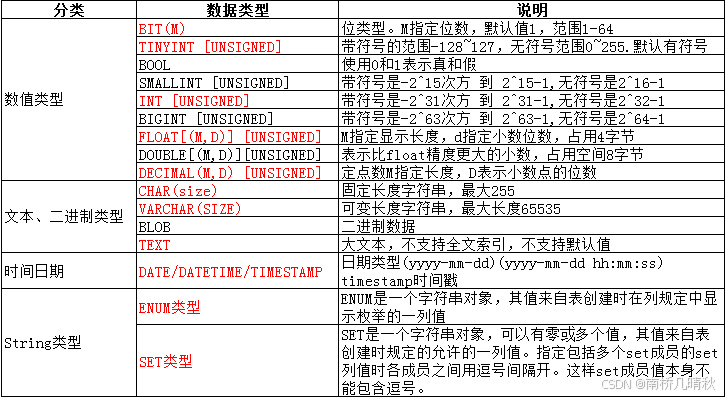
数值类型
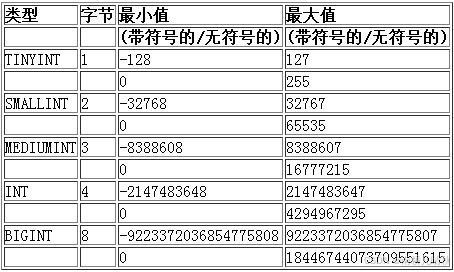
tinyint类型
创建一个表,表中内容是tinyint型有符号:
mysql> create table if not exists t1 (
-> num tinyint
-> );
Query OK, 0 rows affected (0.16 sec)
mysql> desc t1;
+-------+---------+------+-----+---------+-------+
| Field | Type | Null | Key | Default | Extra |
+-------+---------+------+-----+---------+-------+
| num | tinyint | YES | | NULL | |
+-------+---------+------+-----+---------+-------+
1 row in set (0.04 sec)tinyint数据越界测试:
mysql> insert into t1 values (-128);
Query OK, 1 row affected (0.01 sec)
mysql> insert into t1 values (-127);
Query OK, 1 row affected (0.00 sec)
mysql> insert into t1 values (0);
Query OK, 1 row affected (0.00 sec)
mysql> insert into t1 values (-1);
Query OK, 1 row affected (0.00 sec)
mysql> insert into t1 values (1);
Query OK, 1 row affected (0.01 sec)
mysql> select * from t1;
+------+
| num |
+------+
| -128 |
| -127 |
| 0 |
| -1 |
| 1 |
+------+
5 rows in set (0.00 sec)
mysql> insert into t1 values (129);
ERROR 1264 (22003): Out of range value for column 'num' at row 1
mysql> insert into t1 values (-129);
ERROR 1264 (22003): Out of range value for column 'num' at row 1由此可见,tinyint是有符号的范围是-128 ~ 127。
创建一个表,表中内容是tinyint unsigned型无符号:
mysql> create table if not exists t2(
-> num tinyint unsigned
-> );
Query OK, 0 rows affected (0.03 sec)
+-------+------------------+------+-----+---------+-------+
| Field | Type | Null | Key | Default | Extra |
+-------+------------------+------+-----+---------+-------+
| num | tinyint unsigned | YES | | NULL | |
+-------+------------------+------+-----+---------+-------+
1 row in set (0.00 sec)tinyint unsigned数据越界测试:
mysql> insert into t2 values (0);
Query OK, 1 row affected (0.01 sec)
mysql> insert into t2 values (100);
Query OK, 1 row affected (0.00 sec)
mysql> insert into t2 values (-1);
ERROR 1264 (22003): Out of range value for column 'num' at row 1
mysql> insert into t2 values (255);
Query OK, 1 row affected (0.01 sec)
mysql> insert into t2 values (256);
ERROR 1264 (22003): Out of range value for column 'num' at row 1由此可见,tinyint unsigned是有符号的范围是0 ~ 255。
总结: 如果插入的数据超过MySQL数据类型的范围,那么MySQL就不让你插入,直接拦截,不让做对应的操作。这点和C/C++一样,但是编译器不会报错,语言上给你发生截断,编译器内部可能会隐式转换。 如果已经有数据被成功插入到MySQL中,那么插入的时候一定是合法的。 因此,MySQL中,一般而言,数据类型本身也是一种约束。这种约束倒逼程序员,让程序员尽可能正确插入,如果不正确插入,MySQL也能保证插入的数据合法性。这样就能保证数据库中的数据是可预期完整的。
在MySQL表中建立属性列:列名称 类型例如:num tinyint unsigned
注意: 尽量不使用unsigned,对于int类型可能存放不下的数据,int unsigned同样可能存放不下,与其如此,还不如设计时,将int类型提升为bigint类型。
bit类型
基本语法:
bit[(M)] : 位字段类型。M表示每个值的位数,范围从1到64。如果M被忽略,默认为1。
mysql> create table if not exists t3( id int, online bit(1) );
Query OK, 0 rows affected (0.03 sec)
mysql> desc t3;
+--------+--------+------+-----+---------+-------+
| Field | Type | Null | Key | Default | Extra |
+--------+--------+------+-----+---------+-------+
| id | int | YES | | NULL | |
| online | bit(1) | YES | | NULL | |
+--------+--------+------+-----+---------+-------+
2 rows in set (0.00 sec)做插入测试:
mysql> insert into t3 (id,online) values (123,0);
Query OK, 1 row affected (0.00 sec)
mysql> insert into t3 (id,online) values (124,1);
Query OK, 1 row affected (0.00 sec)
mysql> insert into t3 (id,online) values (124,3);
ERROR 1406 (22001): Data too long for column 'online' at row 1
mysql> insert into t3 (id,online) values (124,2);
ERROR 1406 (22001): Data too long for column 'online' at row 1因此,bit为只有一位。
查看刚刚插入的位结构:
mysql> select * from t3;
+------+----------------+
| id | online |
+------+----------------+
| 123 | 0x00 |
| 124 | 0x01 |
+------+----------------+
2 rows in set (0.00 sec)将bit位改成10,即bit(10):
mysql> alter table t3 modify online bit(10);
Query OK, 2 rows affected (0.13 sec)
Records: 2 Duplicates: 0 Warnings: 0
mysql> desc t3;
+--------+---------+------+-----+---------+-------+
| Field | Type | Null | Key | Default | Extra |
+--------+---------+------+-----+---------+-------+
| id | int | YES | | NULL | |
| online | bit(10) | YES | | NULL | |
+--------+---------+------+-----+---------+-------+
2 rows in set (0.00 sec)此时再去插入3,5,10等就可以插入,因为bit位数变多了。
设置位图结构时,最多只能是64位:
mysql> create table if not exists t4(
-> id int,
-> online bit(65)
-> );
ERROR 1439 (42000): Display width out of range for column 'online' (max = 64)后面的括号如果什么都不带,默认建立的是位数为1的位图结构:
mysql> create table if not exists t4( id int, online bit );
Query OK, 0 rows affected (0.03 sec)
mysql> desc t4;
+--------+--------+------+-----+---------+-------+
| Field | Type | Null | Key | Default | Extra |
+--------+--------+------+-----+---------+-------+
| id | int | YES | | NULL | |
| online | bit(1) | YES | | NULL | |
+--------+--------+------+-----+---------+-------+
2 rows in set (0.00 sec)浮点类型
float
语法:
float[(m, d)] [unsigned] : M指定显示长度,d指定小数位数,占用空间4个字节。
样例:
小数:float(4,2)表示允许存装数据的位数是4,精度部分是3个。
mysql> create table if not exists t5(
-> id int,
-> salary float(4,2)
-> );
Query OK, 0 rows affected, 1 warning (0.03 sec)
mysql> desc t5;
+--------+------------+------+-----+---------+-------+
| Field | Type | Null | Key | Default | Extra |
+--------+------------+------+-----+---------+-------+
| id | int | YES | | NULL | |
| salary | float(4,2) | YES | | NULL | |
+--------+------------+------+-----+---------+-------+
2 rows in set (0.00 sec)插入数据:
mysql> insert into t5 (id,salary) values (1,99.99);
Query OK, 1 row affected (0.00 sec)
mysql> insert into t5 (id,salary) values (1,-99.99);
Query OK, 1 row affected (0.01 sec)
mysql> insert into t5 (id,salary) values (1,12.3);
Query OK, 1 row affected (0.01 sec)
mysql> select * from t5;
+------+--------+
| id | salary |
+------+--------+
| 1 | 99.99 |
| 1 | -99.99 |
| 1 | 12.30 |
+------+--------+
3 rows in set (0.00 sec)在进行浮点数存储时,要求2位精度,但是你存入更高的精度,那么就会四舍五入:
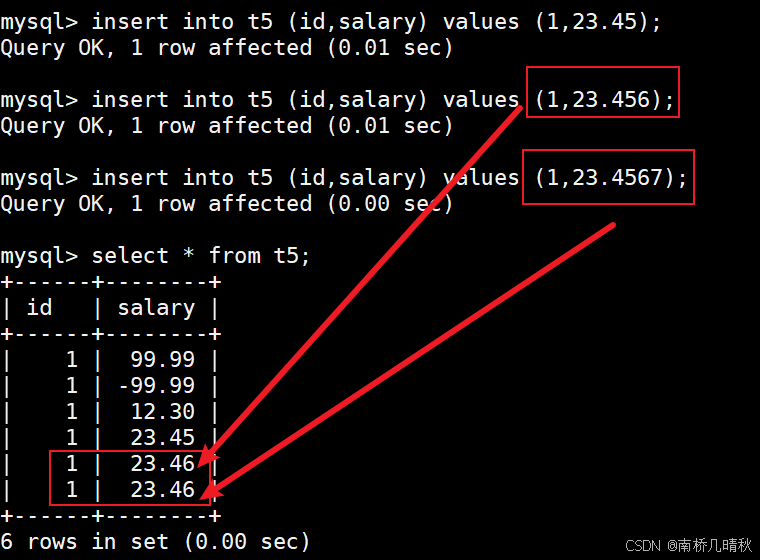

建立一个无符号类型的浮点数:
mysql> create table if not exists t6(
-> id bigint,
-> salary float(4,2) unsigned
-> );
Query OK, 0 rows affected, 2 warnings (0.08 sec)
mysql> desc t6;
+--------+---------------------+------+-----+---------+-------+
| Field | Type | Null | Key | Default | Extra |
+--------+---------------------+------+-----+---------+-------+
| id | bigint | YES | | NULL | |
| salary | float(4,2) unsigned | YES | | NULL | |
+--------+---------------------+------+-----+---------+-------+
2 rows in set (0.00 sec)插入数据测试:
mysql> insert into t6 (id,salary) values(1,99.99);
Query OK, 1 row affected (0.00 sec)
mysql> insert into t6 (id,salary) values(1,-99.99);
ERROR 1264 (22003): Out of range value for column 'salary' at row 1
mysql> insert into t6 (id,salary) values(1,-1);
ERROR 1264 (22003): Out of range value for column 'salary' at row 1decimal
语法:
decimal(m, d) [unsigned] : 定点数m指定长度,d表示小数点的位数
decimal(5,2)表示的范围是 -999.99 ~ 999.99decimal(5,2) unsigned表示的范围 0 ~ 999.99 decimal和float很像,但是有区别: float和decimal表示的精度不一样
mysql> create table if not exists t7( f1 float(10,8), f2 decimal(4,2) );
Query OK, 0 rows affected, 1 warning (0.05 sec)它的使用和float一模一样,但是它的精度更准确一些。

字符串类型
char
语法:
char(L): 固定长度字符串,L是可以存储的长度,单位为字符,最大长度值可以为255。
样例:
mysql> create table if not exists t8(
-> id int,
-> name char(2)
-> );
Query OK, 0 rows affected (0.02 sec)
mysql> desc t8;
+-------+---------+------+-----+---------+-------+
| Field | Type | Null | Key | Default | Extra |
+-------+---------+------+-----+---------+-------+
| id | int | YES | | NULL | |
| name | char(2) | YES | | NULL | |
+-------+---------+------+-----+---------+-------+
2 rows in set (0.01 sec)插入的数据超出固定长度则无法插入:

可以插入汉字:
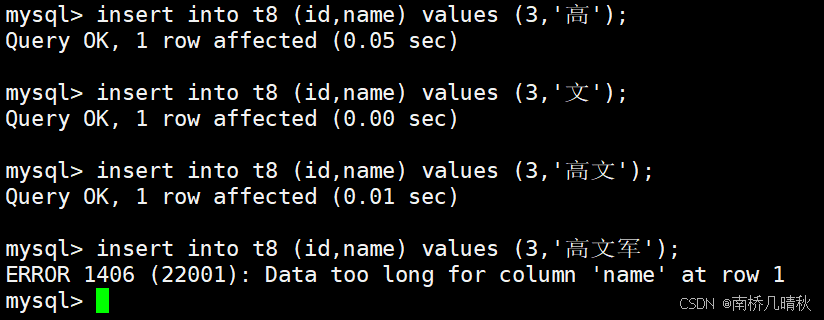
varchar
语法:
varchar(L): 可变长度字符串,L表示字符长度,最大长度65535个字节
样例: 创建一个表:
mysql> create table if not exists t9(
-> id int,
-> name varchar(6)
-> );
Query OK, 0 rows affected (0.02 sec)插入数据,超出6,则无法插入:
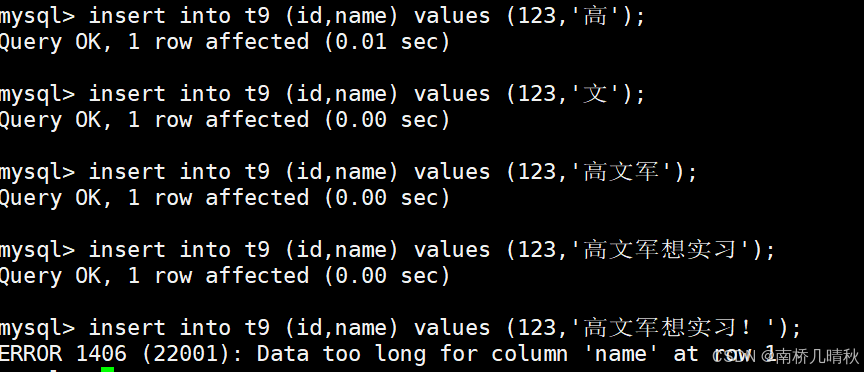
说明: 关于varchar(len),len到底是多大,这个len值,和表的编码密切相关:
- varchar长度可以指定为0到65535之间的值,但是有1 - 3 个字节用于记录数据大小,所以说有效字节数是65532。
- 当我们的表的编码是utf8时,varchar(n)的参数n最大值是65532/3=21844[因为utf中,一个字符占用3个字节],如果编码是gbk,varchar(n)的参数n最大是65532/2=32766(因为gbk中,一个字符占用2字节)。
char和varchar对比

如何选择定长或变长字符串?
- 如果数据确定长度都一样,就使用定长(char),比如:身份证,手机号,md5
- 如果数据长度有变化,就使用变长(varchar), 比如:名字,地址,但是你要保证最长的能存的进去。
- 定长的磁盘空间比较浪费,但是效率高。
- 变长的磁盘空间比较节省,但是效率低。
- 定长的意义是,直接开辟好对应的空间
- 变长的意义是,在不超过自定义范围的情况下,用多少,开辟多少
日期和时间类型
常用的日期有如下三个:
date:日期'yyyy-mm-dd',占用三字节datetime时间日期格式'yyyy-mm-dd HH:ii:ss'表示范围从1000到9999,占用八字节timestamp:时间戳,从1970年开始的yyyy-mm-dd HH:ii:ss格式和datetime完全一致,占用四字节
样例: 创建表:
mysql> create table if not exists t10(
-> t1 date,
-> t2 datetime,
-> t3 timestamp
-> );
Query OK, 0 rows affected (0.04 sec)插入数据:
mysql> insert into t10 (t1, t2) values('2024-7-23','2024-7-23 17:14:00');
Query OK, 1 row affected (0.01 sec)
mysql> select * from t10;
+------------+---------------------+------+
| t1 | t2 | t3 |
+------------+---------------------+------+
| 2024-07-23 | 2024-07-23 17:14:00 | NULL |
+------------+---------------------+------+
1 row in set (0.00 sec)enmu和set类型
语法:
enum:枚举,“单选”类型;
enum('选项1','选项2','选项3',...);
该设定只是提供了若干个选项的值,最终一个单元格中,实际只存储了其中一个值;而且出于效率考虑,这些值实际存储的是“数字”,因为这些选项的每个选项值依次对应如下数字:1,2,3,…最多65535个;当我们添加枚举值时,也可以添加对应的数字编号。
set:集合,“多选”类型;
set('选项值1','选项值2','选项值3', ...);
该设定只是提供了若干个选项的值,最终一个单元格中,设计可存储了其中任意多个值;而且出于效率考虑,这些值实际存储的是“数字”,因为这些选项的每个选项值依次对应如下数字:1,2,4,8,16,32,…最多64个
说明:不建议在添加枚举值,集合值的时候采用数字的方式,因为不利于阅读。
mysql> create table if not exists votes(
-> username varchar(30),
-> gender enum('男','女'),
-> hobby set('代码','羽毛球','乒乓球','篮球','游泳')
-> );
Query OK, 0 rows affected (0.03 sec)插入的时候,性别列只能插入‘男’或者‘女’或者插入相应常量的下标,下表是按照枚举的顺序来的。
mysql> insert into votes values('貂蝉','女','代码');
Query OK, 1 row affected (0.01 sec)
mysql> insert into votes values('关羽','男','代码');
Query OK, 1 row affected (0.01 sec)
mysql> insert into votes values('关羽',1,'代码');
Query OK, 1 row affected (0.01 sec)
mysql> insert into votes values('关羽',2,'代码');
Query OK, 1 row affected (0.01 sec)
mysql> select * from votes;
+----------+--------+--------+
| username | gender | hobby |
+----------+--------+--------+
| 张飞 | 男 | 代码 |
| 貂蝉 | 女 | 代码 |
| 关羽 | 男 | 代码 |
| 关羽 | 男 | 代码 |
| 关羽 | 女 | 代码 |
+----------+--------+--------+
5 rows in set (0.00 sec)如果是集合类型,不可以插入集合中不存在的元素,可以以逗号为分隔符,插入好几个。 采用比特位位置来个set中的爱好对应起来
mysql> insert into votes values('曹操',1,'乒乓球,篮球,代码');
Query OK, 1 row affected (0.01 sec)
在enmu中筛选出男:
```bash
select * from votes where gender='男';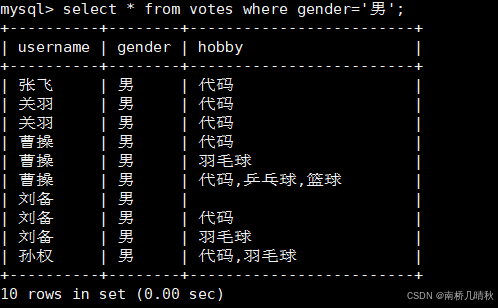
在集合中筛选出喜欢羽毛球的:
select * from votes where hobby='羽毛球';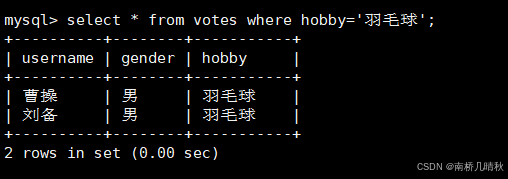
这里问题来了,要筛选的是筛选出喜欢羽毛球的,不是筛选出只喜欢羽毛球的,于是就有了集合查询。
MySQL筛选函数
集合查询使用find_ in_ set函数:
find_in_set(sub,str_list) :如果 sub 在 str_list 中,则返回下标;如果不在,返回0;
str_list 用逗号分隔的字符串。
a在a,b,c中,d不在a,b,c中:
mysql> select find_in_set('a','a,b,c');
+--------------------------+
| find_in_set('a','a,b,c') |
+--------------------------+
| 1 |
+--------------------------+
1 row in set (0.00 sec)
mysql> select find_in_set('d','a,b,c');
+--------------------------+
| find_in_set('d','a,b,c') |
+--------------------------+
| 0 |
+--------------------------+
1 row in set (0.00 sec)查询喜欢打羽毛球的人:

筛选喜欢代码和羽毛球的人:

